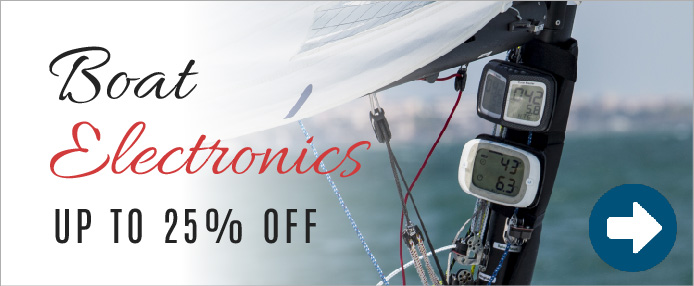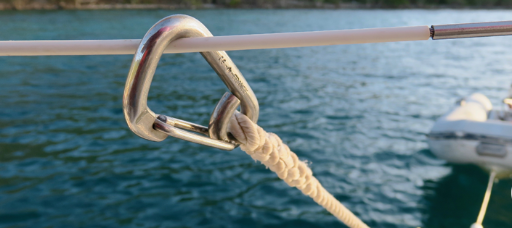Snap hooks
Snap hooks are essential sailing hardware components designed for secure, fast and reliable attachment under load. Used across cruising yachts, racing sailboats and workboats, they provide quick connection for sheets, halyards, safety lines and general deck applications. Our snap hook range includes stainless-steel and forged alloy options from leading manufacturers such as Wichard, Ronstan and 1852, combining strength, corrosion resistance and precise engineering to ensure safe and efficient operation on board. Read more...
Snap hooks play a fundamental role in modern sailing systems, where reliability, speed of connection, and resistance to harsh marine environments are critical. They are a versatile component, found across a yacht’s rigging and deck hardware, and serve applications from attaching halyards and sheets to securing safety equipment or rigging control systems. The design principle is simple: a spring-loaded gate enables rapid connection and disconnection, while the forged body maintains structural integrity under significant working loads. However, material choice, manufacturing method and geometry all influence performance, making the selection of the right snap hook an important technical consideration for any sailor.
Snap Hook Materials and Corrosion Resistance
Marine-grade stainless steel remains the dominant choice for snap hooks, offering high resistance to corrosion in saltwater environments while retaining excellent mechanical strength. The alloys typically used—AISI 316L in particular—provide resistance to pitting and stress corrosion cracking, which are critical concerns in high-load sailing applications. Forged stainless-steel snap hooks, such as those from Wichard, deliver enhanced grain alignment and structural reliability compared with cast alternatives. For less demanding applications, such as light deck fittings or equipment stowage, 1852 offers stamped stainless steel hooks that balance cost-effectiveness with adequate corrosion protection.
Manufacturing Methods
There are three primary methods of snap hook production: forging, precision casting and stamping. Forging is considered the highest standard in marine hardware, as it compacts the grain structure of the metal, increasing both yield strength and impact resistance. Wichard has built its reputation on forged stainless steel hardware, ensuring consistent load ratings and safety factors suitable for offshore and racing yachts. Casting enables more complex geometries at lower cost, but introduces porosity risk and slightly lower structural performance. Stamped snap hooks, offered by brands such as 1852, are economical solutions for light- to medium-duty use, particularly where the loads are predictable and non-critical.
Mechanical Features and Safety
Not all snap hooks are designed equally, and sailors should be attentive to load ratings, spring mechanism quality, and gate security. Ronstan’s range includes spring hooks engineered for sheet and halyard connections, with carefully calibrated springs that ensure reliable closure even after repeated cycles in a saltwater environment. Some Wichard models incorporate a screw-locking mechanism for additional security, preventing accidental opening under torsional load or vibration. This is particularly relevant when snap hooks are used in safety harness lines or man-overboard prevention systems.
Breaking load ratings vary considerably across the range. Lightweight hooks for general deck use may be rated at 200–300 kg, while forged safety snap hooks can exceed 2000 kg, providing redundancy for critical applications. It is important to match the working load limit (WLL) to the intended function, accounting for dynamic shock loads that often occur during sailing manoeuvres.
Snap Hook Brand Focus
Wichard
Wichard snap hooks are widely regarded for their forging expertise. Their products offer consistent metallurgical integrity, with high breaking loads relative to size. Many models include features such as locking gates, swivel eyes and ergonomic release designs that allow operation under load. Wichard’s ISO 9001-certified production ensures traceability and quality assurance, which is especially important for safety-related components. They are frequently chosen for bluewater cruising yachts and offshore race boats where failure is not an option.
Wichard Snap Hooks
Ronstan
Ronstan provides a broad range of snap hooks with a focus on performance-to-weight ratio and functional reliability. Ronstan hooks often feature precise spring action and are commonly used in rigging systems where frequent connection and disconnection are required. For example, snap hooks integrated into control line setups benefit from Ronstan’s lightweight but robust stainless steel construction. The brand also offers hooks with integrated swivels, reducing line twist and improving handling efficiency in dynamic rigging applications.
1852
Positioned as a cost-effective alternative, 1852 snap hooks provide practical solutions for sailors looking for reliable equipment at a more accessible price point. Their stamped stainless-steel snap hooks are well-suited for general onboard tasks, such as equipment lashing, fender lines or light sail control duties. While not designed for extreme offshore load cases, they are ideal for coastal cruising and general deck hardware requirements, offering solid corrosion resistance at competitive pricing.
Applications on Board
Snap hooks are used in a variety of technical contexts, including:
• Sail handling: Quick connection of sheets, halyards and outhauls, where reliable attachment and easy release are essential.
• Safety systems: Integration in jacklines, safety harness lines and tethers, often requiring locking snap hooks with higher load ratings and positive closure.
• Deck equipment: Securing gear such as fenders, deck bags and spinnaker poles, where speed of attachment and corrosion resistance are more important than maximum load capacity.
• Rigging and control lines: Particularly in racing yachts, where snap hooks with swivel bases reduce line twist and allow precise trimming.
Technical Considerations When Selecting Snap Hooks
When choosing snap hooks for your yacht, key factors include:
1. Material and corrosion resistance – 316L stainless steel for offshore conditions, with forged options for maximum reliability.
2. Load ratings – Always match breaking load and working load limits to the application, accounting for dynamic factors.
3. Gate design – Standard spring-loaded gates for general use; locking or double-action gates for safety-critical systems.
4. Swivels and geometry – Integrated swivels reduce torsional loads, while eye versus hook terminations influence compatibility with stainless steel shackles or other hardware.
5. Weight and size balance – Particularly important on performance yachts where minimizing unnecessary mass aloft is critical.
Conclusion on Snap Hooks
Snap hooks are an indispensable part of sailing hardware, delivering secure, efficient and adaptable connection solutions across a wide spectrum of applications. From the forged stainless-steel precision of Wichard, to the high-performance rigging solutions from Ronstan, and the practical cost-effective alternatives from 1852, sailors can select the right snap hook for every application. Careful consideration of material, load capacity, and design ensures reliable performance and safety, whether cruising, racing or undertaking offshore passages. For complementary rigging solutions, explore our ranges of stainless steel shackles, blocks and sheaves, and furling systems to build a fully optimised deck layout.

To install this Web App in your iPhone/iPad press
![]() and then Add to Home Screen.
and then Add to Home Screen.



